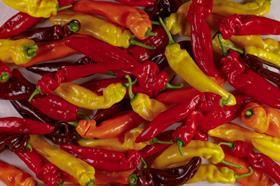
Breeders at Dutch vegetable seed company Rijk Zwaan are increasingly focusing on product colour as one of the most important criteria, according to breeding manager for paprika and aubergines Silvester de Nooijer, as the belief grows that a varied and colourful fruit and vegetable display holds a visual appeal for consumers and can encourage them to choose products that are tastier and healthier.
“The key driver is the market, which is continuously looking for ways to diversify,” said de Nooije. “Growers and retailers want products with new colours. If they can combine different colours in a single pack it offers them added value, resulting not only in premium products on the shelves but also in more variation on people’s plates.
'Colour creates more diversity, especially in salads,' he noted. 'Rijk Zwaan is happy to contribute to this development as an innovative partner.”
How is the desired colour achieved? According to de Nooijer, in peppers Rijk Zwaan has a good understanding of which genes influence colour, but he admits that the company still has some way to go.
“It’s about getting everything right,” he confirmed. “We want a new variety to be a combination of lots of positive traits, such as flavour, shape and technical characteristics.
'In the new orange and chocolate variants within the sweet pointed pepper segment, for example, we’re focusing strongly on flavour because the unique taste of our main variety – Palermo RZ – sets a high standard,' he explained. 'The fruit length must be reasonably uniform too so that differently coloured pointed peppers can be sold together in the same pack.”
Colour is not only a consideration in sweet pointed peppers, but also in snack peppers, snack tomatoes, kohlrabi, aubergines and many other crops.
“Each one has its own palette of colours, so although we already know what determines the base colour, it’s a lot more complex to find the genes that influence its intensity,” said de Nooijer. “We still keep searching though. A fresh light green colour can make snack vegetables look even more appealing.”
Rijk Zwaan takes into consideration the fact that each market may have different preferences when it comes to certain traits, and colour is no different – consumers may like dark red skin on a product in one country, and light red in another.
“We take that into consideration,” de Nooijer confirmed. “We see more colour variation in mature retail markets such as the US, Canada and western Europe – where stores also sell yellow and orange products in addition to green and red ones – than in more traditional markets.
'We expect the diversification trend in the fresh produce category to continue all over the world and we are happy to play a part in that as Rijk Zwaan,' he added. 'That’s how we share a healthy future.”



